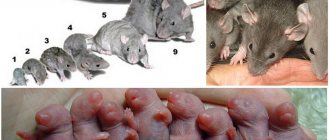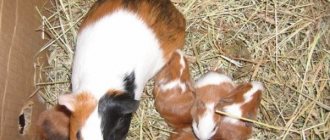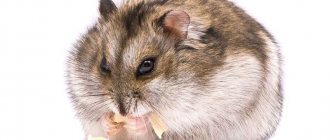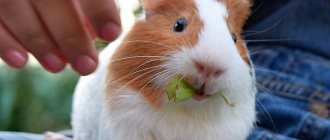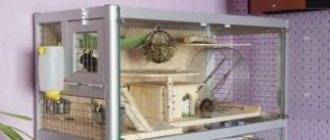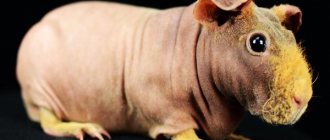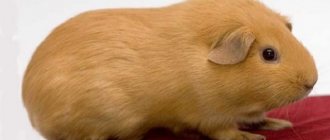Japanese dwarf or dancing mice are excellent pets for those who like to keep pet rodents. They are decorative, sociable and interesting. But before you get this miniature animal, read the brief tips on its maintenance and care. What does a mouse need to live happily?
Japanese dwarf mouse - features of the breed
The bamboo mouse is a subspecies of the house mouse.
The breed was developed in Japan: initially the animals were bred to feed snakes, then used for laboratory experiments.
As a result of selection, individuals of extremely small sizes with spotted fur appeared.
External characteristics of animals:
- elongated head shape, large rounded ears;
- body length - from 2 cm to 4 cm, weight - up to 7 g. The tail of the animal can reach 3.5 cm;
- the lifespan of a rodent is 1.5-2 years;
- The coat is silky, white with large black, gray or reddish spots, randomly located throughout the body.
These mice are also found in nature: rodents live on the edge of mixed forests with an undergrowth of Kuril saz (bamboo). In autumn, animals tend to settle near people’s homes.
Mouse's house - what is it like?
It's bad for a mouse to live alone . Therefore, let's assume that we don't have one pet, but at least a couple. Such small animals, of course, do not need a huge container. But it’s also not worth locking the little animals in a tiny carrier.
Mice love to dig . Therefore, there must be a sufficient layer of sawdust at the bottom of the container. I am often asked: “Why is a cage not suitable for Japanese mice?” There are several answers. And one of them is that it’s bad to put sawdust in it. Especially if you don't like them being outside the cage. Therefore, between a cage and a container (aquarium, etc.), we definitely choose a container.
Japanese women love to run . Give your pets the opportunity to run and climb. The container should have several levels with ladders, ropes, and pipes. So that the kids are interested and not bored. Branches brought from the street will also work. Just remember to wash them thoroughly.
The Japanese mouse is hyperactive . They need somewhere to put their energy. The wheel will save the mouse from boredom and allow it to splash out excess energy. Right now I have four wheels spinning behind me at once. I'm still thinking about how to attach a mobile phone charger to them)
Where to live? The house for mice can be absolutely anything. It’s better not to take wooden ones, even though they are very nice. The tree will absorb all the odors and will be a source of stench even when the cage is cleaned. A plastic house without a bottom will do (with a bottom will also work). What else could become a house for mice? Whatever! A jar of cottage cheese, a plastic cup, half a coconut.
Japanese mice - tips on maintenance and care
The diet of bamboo babies is varied. If you are planning to buy rodents, keep in mind that their diet should include both plant and animal foods.
What to feed? – The main diet of the Japanese mouse
Like all other family members, the Japanese mouse eats whole grains:
- corn;
- oats;
- mile;
- sunflower and pumpkin seeds.
Try not to overfeed the mice - feed them once a day, and no more than a teaspoon of grain mixture should be consumed per individual.
Rodents will not refuse fresh vegetables and fruits (carrots, beets, apples, zucchini), dandelion leaves, lettuce, burdock, plantain, and sprouted wheat grains.
White cabbage is not allowed in the diet of mice - the vegetable causes bloating and leads to fermentation in the intestines.
Offer protein foods to your pets at least once a week:
- minced boiled meat or liver;
- low-fat cottage cheese, grated boiled chicken egg white.
Give your mice white or black breadcrumbs 1-2 times a month.
You can water dwarf rodents with regular tap water, after letting it sit in an open container for 5-7 hours. Wash the basin and change the water at least once every 2-3 days. Otherwise, slimy colonies of cyanobacteria may form on the walls of the container, which is unsafe for animal health.
Do you specifically maintain water for rodents? The survey experience is limited because JavaScript is disabled in your browser.
IMPORTANT! Use vitamin supplements with caution, since hypervitaminosis is no less dangerous than a lack of nutrients in the body. Special preparation is required if the mouse has not received vegetables and fruits for a long time, the animal has lost activity, and the fur looks dirty and dull.
Requirements and arrangement of residence
For a married couple consisting of two people, a small case will be enough: a plastic terrarium measuring 410x320x220 (mm, LxWxH) with a lid. You can also use a cage, but the distance between the rods should not be more than 5 mm.
To make your pet comfortable, equip the terrarium with the following accessories:
- ladders, climbing shelves;
- racing wheel or ball;
- branches of fruit trees, mineral stone, gypsum (the teeth of Japanese mice grow throughout their lives and need constant grinding);
- house (rodents will hide in such “holes” or make a nest in this place). Half a coconut shell or a broken flowerpot will be suitable as housing material;
- Place medium-sized sawdust (or crushed corn on the cob) in the bottom of the cage and add a small amount of baking soda (to reduce mouse odor). Change the litter tray once a week, combining the process with wet cleaning of your pet's home. This time, transfer the “hosts” to another cage;
- Place a shallow container of water in the mouse house or hang an automatic waterer outside.
ATTENTION! Maintain the temperature in the terrarium at 20-22 ° C, place the container with rodents in a place that excludes direct sunlight and drafts on the mice.
Features of behavior
Dwarf pets are very active: animals wander for a long time in one place or jump on the wall of their home.
A distinctive feature of rodents is their movement along a zigzag path, reminiscent of a dance. This behavior indicates a disruption of the animal’s pituitary gland or damage to the inner ear. The stronger the “dance” symptoms, the more severely the brain appendage is affected.
Japanese mice have a slight natural odor, are incredibly clean, and love to spend time brushing their friend's fur. Animals bathe in the sand. If the mouse gets very dirty, wipe it with a soft, damp cloth.
Animals quickly become attached to humans, sensitively reacting to changes in the emotional tone of the owner and expressing their joy or displeasure with the help of various sounds. Mice do not show aggression. The bite could be from a wild animal or from a female in late pregnancy.
It is undesirable to have an individual, as the animal will get bored and may die.
Optimal content options:
- two females;
- Man and woman;
- a male and several females.
IMPORTANT! Do not allow mating of two “dancing” individuals: the resulting offspring will not be viable.
Breeding
Sexual maturity of Japanese mice occurs at the age of 1 month after birth, reproduction is possible throughout the year. Females carry cubs for 20 days, and there are up to 6-7 mice in a litter.
During pregnancy and after childbirth, give the rodent more fresh fruits and vegetables and do not touch the nest with your hands - there is a risk of infecting the babies or worried parents will simply eat all the feces. Change the litter box as usual.
Newborn animals feed on their mother’s milk, and after 20-25 days they begin to eat “adult” food. In this case, the young animals can be placed in a separate house.
Determination of sexual characteristics in mice (aged 7 to 10 days):
- turn the animal over on its back and examine the abdomen: the female will show secondary sexual characteristics (two rows of nipples);
- the distance between the genitals and anus in a woman will be greater than in a man;
- the male has dark spots on the lower abdomen - the future genitals (testicles).
IMPORTANT! Carefully observe the behavior of the male before giving birth and 1-2 days after it: if he continues to chase the female for mating, place him in a separate house for a while.
Housing of individuals
The Japanese dancing mouse must live in a cage specially equipped for this purpose. As a rule, owners choose cages with bars no more than half a centimeter apart, which prevents the animal from escaping while simultaneously providing high-quality ventilation. The housing should contain items for the animal's leisure time:
It must be taken into account that all surfaces should not have protrusions or crevices where a pet’s paw could get stuck. It is also necessary to take into account the size of the animal and select a running wheel that will not be too heavy and uncomfortable.
The Japanese mouse emits a pungent odor characteristic of all its relatives. In this regard, cleaning the cage should be carried out at least once every three days, otherwise both your home and the level of hygiene in your pet’s cage will suffer from the constant smell. As a filler, you can use ordinary medium-sized sawdust. It is not recommended to use sawdust with flavoring; they often provoke allergic reactions.
In housing, the animal must equip its own house. You can purchase a ready-made one at a pet store - they offer various wooden, ceramic or plastic options. For a nest, you can provide the animal with pieces of napkins, which he will independently use in the house.
conclusions
The Japanese mouse is a funny and very interesting pet. Keeping and caring for animals is simple. However, if there are small children in the house, it is not recommended to buy a dwarf rodent - a child who wants to pet the mouse or catch it may accidentally harm it.
Rats What can and cannot be given to rats: a detailed table of goods Hello friends, in this table we tried to collect 65 64.2k.
Rats Make friends with a decorative pet mouse. Let's quickly and easily tame a small rodent in our arms. A mouse, like any animal, requires training. 10 21k.
Rodents Rodents are so different: which animal to choose for an apartment, a private house, for a child Traditionally, rodents are considered to be 0 20.8 thousand people.
Rats The rat is breathing heavily, grunting or choking. How can you help your beloved pet? Pets are often dangerous to our health. 8 19.4k.
Guinea pigs The best litter for a guinea pig: tips for choosing litter in a cage A guinea pig is like any other pet 0 17.6k.
Rodent diet
Like any other mouse, the Japanese one eats:
All that should be remembered when feeding the animal is that it does not tolerate food from the human table. The Japanese mouse (photo can be seen on the page), like its relatives, cannot tolerate the smell of spices and excess salt in food.
As protein supplements, you can give animals low-fat cottage cheese, pieces of chicken fillet boiled without salt and spices, liver prepared in the same way, gammarus, shrimp, boiled egg white.
In order to provide the animals with drinking water, it is necessary to hang a drinking bowl on the wall of the cage.
The water needs to be changed at least once every 2-3 days.
It is necessary to periodically wash the inside of the drinker, otherwise blue-green algae will appear in it.
It is worth knowing that these animals are distinguished by exceptional mobility and jump quite high. If the animal is not yet accustomed to being handled, you can only pick it up by the tail. Hand training is carried out gradually; the owner will need a lot of patience and tasty treats, with the help of which he will develop positive associations with his hands in the animal.
What to eat?
Eat and drink. I think no one will forget that pets need to be fed and watered. Don't listen to those who say mice don't need water. Everyone needs water. And we have two options. Or we feed the mice mainly grain (food from a box) and hang a drinking bowl. Or in the morning we give them porridge with water, always in small quantities of vegetables, unsweetened fruits, and grains as the basis of the diet. If 40% of the diet is “wet” food, then you don’t need to add water. Isn't it easier to hang a drinking bowl?
Total: a feeder and a drinker should be in each container.
Vitamins and minerals . With a balanced diet, additional vitamins are not needed. But a salt stone should be in every container. If the mouse is pregnant or nursing, you can add vitamins to its diet. They are bought in pet stores; I have no desire to advertise any specific ones. The main thing is not to overdo it. Remember that our animal is extremely small, which means it needs very few vitamins. Hypervitaminosis is just as bad as hypovitaminosis.
Do not overfeed the animal. The baby eats about a teaspoon of food a day. Do not give Japanese mice food from our table - salt is harmful to them and they do not like the smell of spices.
Nutrition
One of the frequently asked questions when purchasing this type of pet is “ what to feed decorative mice .” The answer is simple - almost everyone. Mice are indiscriminate eaters. They love these products:
- corn;
- oats;
- barley;
- corn.
Occasionally you can treat them with a small amount of seeds. Their favorite dishes are curd products, cheese and egg whites (boiled). It should be remembered that these pets, like any other living organisms, require useful substances, so you need to buy them dry food.
Due to the fact that rodents have a very high metabolism, it is necessary to constantly monitor the fullness of the feeder. To reduce the likelihood of dental problems, you should provide mice with twigs from fruit trees, they will grind their teeth on them. Under no circumstances should plants such as:
- wolfberries;
- celandine;
- bracken fern;
- nightshade;
- dope.
The elements contained in the above plants are dangerous to the health of mice and can lead to immediate death.
